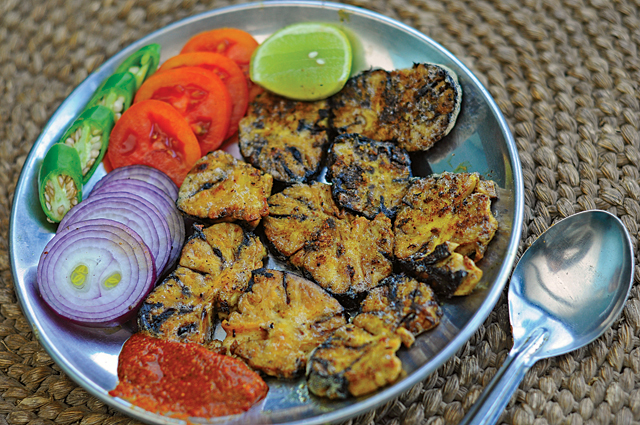You can spoil (or punish) yourself with the dishes at Patan’s local restaurants.
It seemed like my guide for the day, a local who knew Patan’s labyrinthine alleys like his backyard, was intent on getting as far away from the city center as possible. We zoomed past Darbar Square, dodging crazed motorcyclists and squeezing past cars. I tried to take in the places we were passing through, but the streets were all too similar—potholed roads, corner shrines reddened with vermilion, and crumbling wooden houses. I felt like we were going to a clandestine meeting with an art thief, to see an object long thought to have been smuggled out of the country.

My guide, a photographer by profession, stopped the bike at a crossroads and parked it alongside a line of others. In the distance I could see a crane towering over high-rises. The neighborhood was unusually quiet and empty for a place of Patan’s urban density. Cars were a rarity; motorbikes passed by occasionally. My guide pointed to a doorway and we walked toward it. A thin curtain concealed whatever was inside. I could sense that I was going to experience something I had never done before.
That was the plan. My guide had brought me to this place to try a few things—a few Newari delicacies, to be precise. It was a local eatery, one of several, he told me, in the neighborhood. Several? Where were the other places? I hadn’t noticed any signboards for restaurants, nothing to catch a passerby’s eye and lure him in. “These type of eateries don’t advertise,” my photographer friend said. “Every neighborhood has places like this that specialize in one kind of dish or another. The regular customers, most of them locals living in the same neighborhood, know these places, so they never feel the need to put up signboards.” Later, when we went outside after having tasted some of the eatery’s famous dishes, I noticed that it did have a signboard bearing its name. My friend explained that it was an exception. Most of the times you needed a local’s help to find these places.
Inside the eatery I suddenly found myself having to select dishes out of a long table laid out with almost every item that can be made from buffalo meat. This abundance of delicacies was a result of the Newar culinary tradition of using almost every part of a buffalo. My guide quickly realized that I was in a fix. To help me, he began naming the place’s specialties. I went for fried buffalo brain, sapo micha (bone marrow stuffed in intestines), and the eatery’s best-selling item, palu kachila (raw meat mixed with spices and salad).

Fried brain turned out to be somewhat like fried fish. The achar served with it was a great combination. On tasting it, all the tenderness of the succulent brain that the tongue had enjoyed was swept away by the onslaught of chilly. I later realized this achar also served, albeit this was not the reason for its presence on the plate, to prepare the taste buds for a bit of heat. The next item I tried, sapo micha, was a sensual experience. With its spiky exterior, the deep fried rosebud-shaped pieces gave me doubts. But what followed the crunch of this exterior’s breaking in the mouth was delectable: buttery bone marrow.
But the bliss induced by this dish couldn’t have been more contradictory to what we had come to sample. The first few bites of the palu kachila were as expected—soft, succulent and a bit chewy. But halfway through the plate I began to feel the need to eat more and more chiura. The spices, especially the chilly, in the dish had begun to take effect. Periods in between sentences began to be filled with the sound of sucking in air—the language of those transported, by chilly, to a torture chamber for the tongue. But that didn’t make me stop eating. It was a dish for those who can handle chilly. That it made me, a person who keeps away from chilly, still keep devouring it was testimony to its deliciousness. It was also a dish to eat during the cold winter months, so that you walked away from the place with a little fire in your mouth and belly.
My tongue’s recovery was expedited by two dollops of spicy meat jelly that the shop owner gave me to sample. As I savored the aftertaste of spices, my stomach warm from the food just eaten, I realized Patan would no longer be only about temples and monasteries and alleys for me.









